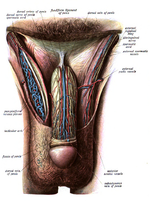Male Reproductive System
The male reproductive system consists of a number of sex organs that play a role in the process of human reproduction. These organs are located on the outside of the body and within the pelvis.The main male sex organs are the penis and the testicles which produce semen and sperm, which, as part of sexual intercourse, fertilized an ovum in the female's body; the fertilized ovum (zygote ) develops into a fetus, which is later born as an infant.
The corresponding system in females is the female reproductive system .
External genital organs
External male genital organs
Penis
The penis is the male intromittent organ. It has a long shaft and an enlarged bulbous-shaped tip called the gland penis, which supports and is protected by the foreskin . When the male becomes sexually aroused, the penis becomes elect and ready for sexual activity. Erection occurs because sinuses within the erectile tissue of the penis become filled with blood. The arteries of the penis are dilated while the veins are compressed so that blood flows into the erectile cartilageunder pressure. The penis is supplied by the pudendal artery.
Scrotum
The scrotum is a pouch-like structure that hangs behind the penis. It holds and protects the testicles. It also contains numerous nerves and blood vessels. During times of lower temperatures, the Cremaster musclecontracts and pulls the scrotum closer to the body, while the Dartos muscle gives it a wrinkled appearance; when the temperature increases, the Cremaster and Dartos muscles relax to bring down the scrotum away from the body and remove the wrinkles respectively.
The scrotum remains connected with the abdomen or pelvic cavity by the inguinal canal. (The spermatic cord, formed from spermatic artery, vein and nerve bound together with connective tissue passes into the testis through inguinal canal.)
Internal genital organs
Epididymis
The epididymis, a whitish mass of tightly coiled tubes cupped against the testicles, acts as a maturation and storage for sperm before they pass into the vas deferens, that carry sperm to the ampullary gland and prostatic ducts .
Vas deferens
The vas deferens, also known as the sperm duct, is a thin tube approximately 30 centimetres (0.98 ft) long that starts from the epididymis to the pelvic cavity. It carries the spermatozoa from the epididymis to ejaculatory duct.
Accessory glands
Three accessory glands provide fluids that lubricate the duct system and nourish the sperm cells. They are the seminal vehicles , the prostate gland and the bulbourethral glands (Cowper glands).
The embryonic and prenatal development of the male reproductive system is the process whereby the reproductive organs grow, mature and are established. It begins with a single fertilized egg and culminates 38 weeks later with birth of a male child. It is a part of the stages of sexual differentiation. The development of the male reproductive system coincides with the urinary system. The development of them can also be described together as the development of the urinary and reproductive organs.
Development
Sexual determination

Human karyotype
Sexual identity is determined at fertilizationwhen the genetic sex of the zygote has been initialized by a sperm cell containing either an X or Y chromosome. If this sperm cell contains an X chromosome it will coincide with the X chromosome of the ovum and a female child will develop. A sperm cell carrying a Y chromosome results in an XY combination, and a male child will develop.
Genetic sex determines whether the gonads will be testes or ovaries. In the developing embryo if the testes are developed, it will produce and secrete male sex hormones during late embryonic development and cause the secondary sex organs of the male to develop.


Comments
Post a Comment